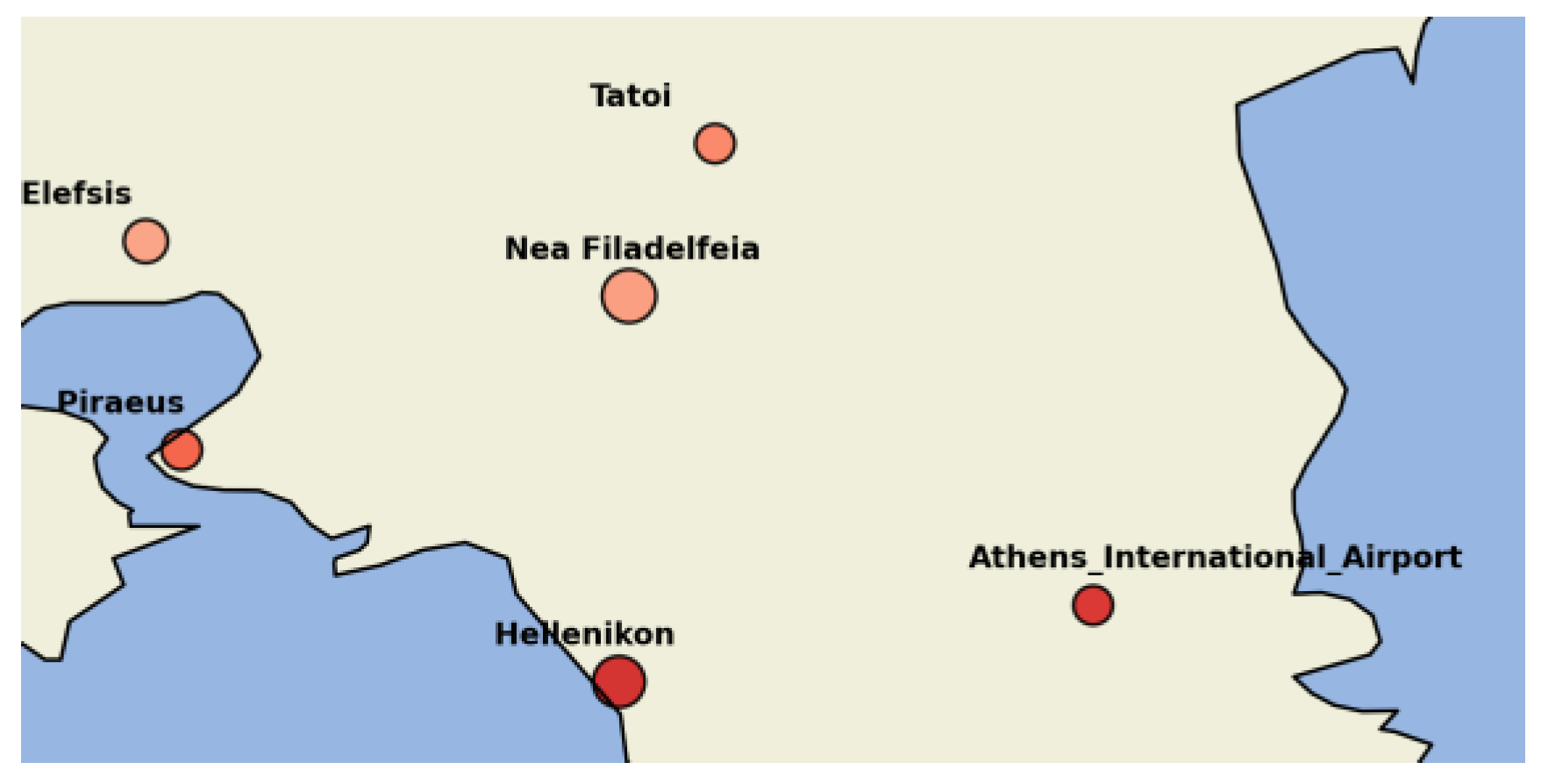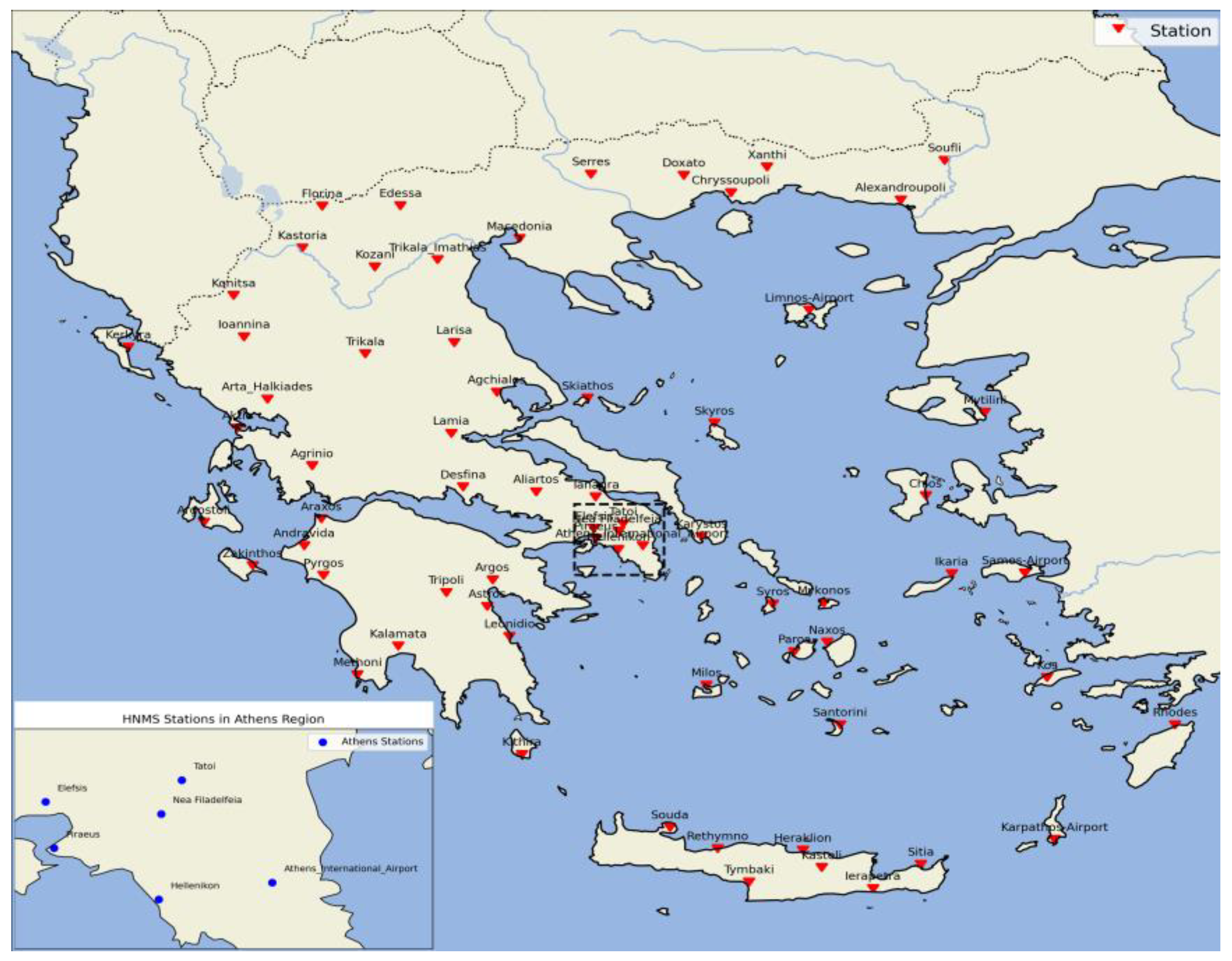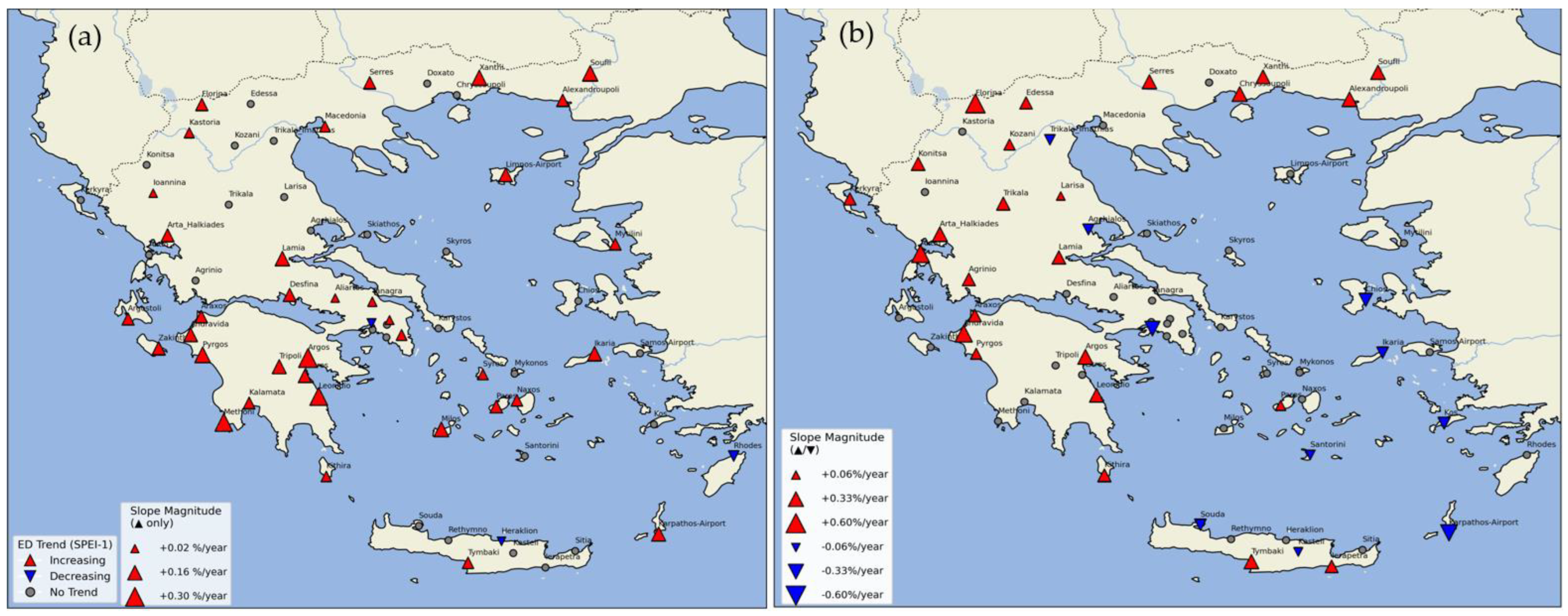A Spatiotemporal Analysis of Droughts in Greece (1960–2022): Severity, Duration and Frequency Based on the SPI and SPEI †
Abstract
1. Introduction
2. Materials and Methods
2.1. Data
2.2. Drought Indices and Classification
2.3. Drought Metrics
2.4. Trend Analysis
3. Results
3.1. Drought Occurrence Probability
3.2. Duration and Intensity
3.3. Temporal Trends in Extreme Drought Occurrence
4. Conclusions
Author Contributions
Funding
Institutional Review Board Statement
Informed Consent Statement
Data Availability Statement
Conflicts of Interest
Appendix A

References
- Vicente-Serrano, S.M.; McVicar, T.R.; Miralles, D.G.; Yang, Y.; Tomas-Burguera, M. Unraveling the influence of atmospheric evaporative demand on drought and its response to climate change. WIREs Clim. Change 2020, 11, e632. [Google Scholar] [CrossRef]
- Ndayiragije, J.M.; Li, F. Effectiveness of Drought Indices in the Assessment of Different Types of Droughts, Managing and Mitigating Their Effects. Climate 2022, 10, 125. [Google Scholar] [CrossRef]
- Nalbantis, I. Evaluation of a Hydrological Drought Index. Eur. Water 2008, 23, 67–77. [Google Scholar]
- Tigkas, D. Drought Characterisation and Monitoring in Regions of Greece. Eur. Water 2008, 23, 29–39. [Google Scholar]
- Kourtis, I.M.; Vangelis, H.; Tigkas, D.; Mamara, A.; Nalbantis, I.; Tsakiris, G.; Tsihrintzis, V.A. Drought Assessment in Greece using SPI and ERA5 Climate Reanalysis Data. Sustainability 2023, 15, 15999. [Google Scholar] [CrossRef]
- Lionello, P.; Scarascia, L. The relation between climate change in the Mediterranean region and global warming. Reg. Environ. Change 2018, 18, 1481–1493. [Google Scholar] [CrossRef]
- Anagnostopoulou, C. Future Drought Projection for the Greek Region. Bull. Geol. Soc. Greece 2016, 50, 1038–1045. [Google Scholar] [CrossRef]
- Politi, N.; Vlachogiannis, D.; Sfetsos, A.; Nastos, P.T.; Dalezios, N.R. High Resolution Future Projections of Drought Characteristics in Greece Based on SPI and SPEI Indices. Atmosphere 2022, 13, 1468. [Google Scholar] [CrossRef]
- McKee, T.B.; Doesken, N.J.; Kleist, J. The relationship of drought frequency and duration to time scales. In Proceedings of the Eighth Conference on Applied Climatology, Anaheim, CA, USA, 17–22 January 1993; American Meteorological Society: Boston, MA, USA, 1993; pp. 179–184. [Google Scholar]
- Vicente-Serrano, S.M.; Beguería, S.; López-Moreno, J.I. A multi-scalar drought index sensitive to global warning: The standardized precipitation evapotranspiration index-SPEI. J. Clim. 2010, 23, 1696–1718. [Google Scholar] [CrossRef]
- Droogers, P.; Allen, R.G. Estimating reference evapotranspiration under inaccurate data conditions. Irrig. Drain. Syst. 2002, 16, 33–35. [Google Scholar] [CrossRef]
- Wang, Q.; Zeng, J.; Qi, J.; Zhang, X.; Zeng, Y.; Shui, W.; Xu, Z.; Zhang, R.; Wu, X.; Cong, J. A multi-scale daily SPEI dataset for drought characterization at observation stations over mainland China from 1961 to 2018. Earth Syst. Sci. Data 2021, 13, 331–341. [Google Scholar] [CrossRef]
- Mokhtar, A.; Jalali, M.; He, H.; Al-Ansari, N.; Elbeltagi, A.; Alsafadi, K.; Abdo, H.G.; Sammen, S.S.; Gyasi-Agyei, Y.; Rodrigo-Comino, J. Estimation of SPEI Meteorological Drought Using Machine Learning Algorithms. IEEE Access 2021, 9, 65505–65523. [Google Scholar] [CrossRef]




| Period | Increasing Trend | No Trend | Decreasing Trend | Slope Range (%/Decade) |
|---|---|---|---|---|
| 1960–2022 | 36 | 28 | 3 | 0.3–0.6 ↓, 0.2–3.0 ↑ 1 |
| 1990–2022 | 25 | 31 | 10 | 0.7–4.1 ↓ 2, 0.6–5.9 ↑ |
Disclaimer/Publisher’s Note: The statements, opinions and data contained in all publications are solely those of the individual author(s) and contributor(s) and not of MDPI and/or the editor(s). MDPI and/or the editor(s) disclaim responsibility for any injury to people or property resulting from any ideas, methods, instructions or products referred to in the content. |
© 2025 by the authors. Licensee MDPI, Basel, Switzerland. This article is an open access article distributed under the terms and conditions of the Creative Commons Attribution (CC BY) license (https://creativecommons.org/licenses/by/4.0/).
Share and Cite
Samouris, M.; Mamara, A.; Armaos, V.; Argiriou, A. A Spatiotemporal Analysis of Droughts in Greece (1960–2022): Severity, Duration and Frequency Based on the SPI and SPEI. Environ. Earth Sci. Proc. 2025, 35, 61. https://doi.org/10.3390/eesp2025035061
Samouris M, Mamara A, Armaos V, Argiriou A. A Spatiotemporal Analysis of Droughts in Greece (1960–2022): Severity, Duration and Frequency Based on the SPI and SPEI. Environmental and Earth Sciences Proceedings. 2025; 35(1):61. https://doi.org/10.3390/eesp2025035061
Chicago/Turabian StyleSamouris, Michael, Anna Mamara, Vasileios Armaos, and Athanassios Argiriou. 2025. "A Spatiotemporal Analysis of Droughts in Greece (1960–2022): Severity, Duration and Frequency Based on the SPI and SPEI" Environmental and Earth Sciences Proceedings 35, no. 1: 61. https://doi.org/10.3390/eesp2025035061
APA StyleSamouris, M., Mamara, A., Armaos, V., & Argiriou, A. (2025). A Spatiotemporal Analysis of Droughts in Greece (1960–2022): Severity, Duration and Frequency Based on the SPI and SPEI. Environmental and Earth Sciences Proceedings, 35(1), 61. https://doi.org/10.3390/eesp2025035061






